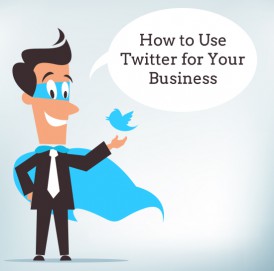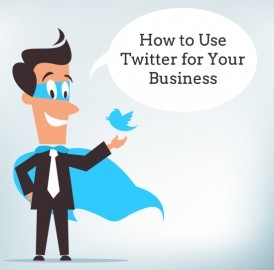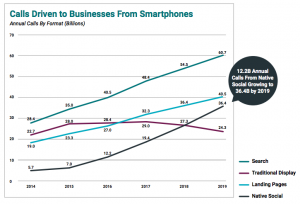
So you’ve set up your company’s Facebook page and it’s going great! Now what?
Well, maybe it’s time to think about creating a Twitter account for your business.
Similar to what I did in my last blog post, first I’ll convince you why you need one:
- Probably the most obvious, it’s an easy way to connect with customers – both potential new ones and current ones.
- Related to #1, it lets your customers give you feedback on your product or service, which can be really important information for product development. You can easily – and publicly – address customer questions and concerns.
- You can post company news and updates that can then spread more easily throughout the interweb than a Facebook post can (think about it: it’s so much easier to hit “retweet” on Twitter than “share” on Facebook).
- You can get new sales leads and conversions by giving out coupons or running promotions. So, yes, Twitter can help your bottom line!
- It’s an easy way to keep tabs on your competition. By simply checking out what they’re tweeting about, how their customers are responding, and how big their following is, you can get an idea of how your company compares.
- It’s also a great way to see what’s trending all over the world (or even in your town) via #hashtags.
Set some goals
So now that you’re convinced about the value of a Twitter account, let’s do something similar to what we did with the Facebook guide and talk about what you want to accomplish with this Twitter account. A lot of companies will simply create the account and start posting without really having any sort of game plan or strategy – that’s almost as bad as having no presence on Twitter at all!
- What’s the goal of your Twitter page? Are you trying to be the go-to resource for others in your industry? Or are you trying to get sales leads? The answer to this question will drive your content strategy.
- Who are you targeting? Like Facebook, you want to have a defined target audience. Will it be other businesses in your industry, or are you targeting reporters that might want to write about your service? This again will vastly change what you’re posting and when.
- How often will you post? There’s no ideal number of times to post per day – you’ll just have to test that out for yourself. See how your audience reacts and measure their engagement through tools like Google Analytics or Moz. Then, tweak your social media calendar based on your results.
- Who will post updates? This is an issue that a lot of companies forget to address, but an important one. Will one person in your company be posting regular updates, or will multiple people have access to the Twitter account? Work out who’s going to post when to avoid repeat content.
- How much of a financial investment will this require? If you’re a small business, maybe you just want to have the Twitter account and manage it internally, but if you’re looking to get fancy, you can advertise on Twitter or hire someone to manage it externally.
Now, for the fun stuff
- Create your Twitter account and handle. It’s best to use your company’s name as your handle. Try to avoid numbers or symbols because they’re hard to remember and make sure the account is public.
- Set your profile photo and cover photo. Your profile photo should usually be your company’s logo and your cover photo can be something that represents what you do. You can change your cover photo to be in tune with any promotions you’re running or events you’re hosting, but your profile picture should generally stay the same.
- Add your company’s description, location, and website! This should be a quick summary of what you do. For bonus points, use #hashtags in the description.
- Add your Twitter account to your website. Make sure it’s in a visible place so that any visitors to your website can easily follow you.

Follow, follow, follow
Now that your account is set up, what do you need? Followers, of course! But first, you have to build your network by following. Start by following others in your industry – if you’re a restaurant, for example, you can follow other restaurants, chefs, food reporters and bloggers, you name it. Anyone that you think is relevant to what you do, follow them. You can also go local – follow restaurants or other businesses around you to see what they’re saying. Maybe there’s hosting a big event next week and you can be a part of it! That’s what Twitter is all about – building communities online and offline.
We also advise companies to follow clients, customers, even competitors. You have to be up to date on what everyone around you is doing.
Caveat: be wary of following too many people at once. Try not to follow more than 25 or 30 accounts per day because you don’t want to be following 100 people and only have 25 followers, because then it looks like 75 people didn’t want to follow you. Give your followers some time to add you back before following a new batch.
One of the most useful ways to sort all of these followers is through Twitter Lists. Perhaps one of the more underutilized tools of Twitter, this is a great way to see only updates from certain groups of people.
Time for you to get some followers
…and the way to do that is to post some great content. Here are some ideas to get you started:
- Articles, blogs, and helpful links from around the web relevant to your industry.
- Pictures go a long way. Did your company have a happy hour on Friday? Your followers want to see pics!
- Along with that, short videos of your office hanging out, or tips on how to use your product. Vine, anyone?
- Events that you’re attending or hosting. Be sure to use the official hashtag so that others who aren’t following you (yet) can see your tweets, too.
- Quotes – both funny and memorable.
- Run a contest or promotion. Offer followers a chance to win a prize for retweeting you.
- Ask a question – for example, ask your followers what their plans are for the weekend. No one wants to follow an account that’s only self-promoting. Show genuine interest in your fans!
- All of your content doesn’t have to be self-generated: you should regularly retweet or mention content from other influencers in your industry.
If you’re able to, try to use #hashtags in the key words of your tweet. #Don’t #overdo #it #like #this, but just pick and choose the major #keywords so that your tweets show up when others click on that hashtag.
Another easy way to get followers is to advertise on Twitter. I love Twitter’s advertising platform because it’s super easy to use and lets you choose a very specific audience that you can target. Tip for Twitter ads: write new tweets that include a call-to-action, such as “Follow us” and tell people why they should follow you.

Finally, the last thing you should be doing is RESPONDING to those who tweet at you! If someone asks you a question, respond to them. And more importantly, if someone complains about your product or service, mitigate the situation quickly so that your other followers see how you handle customer complaints. Taco Bell does a great job with this.
How am I doing?
Of course, you want to measure how your Twitter account is helping your business grow. Unfortunately, Twitter does not have built-in Page Insights like Facebook does, but there are apps that you can download to help you see where your followers are coming from, what they tweet and when, and how you’re stacking up to your competition. Our favorite is Followerwonk. You can access apps by going to Settings > Apps. You can also use Google Analytics or Moz to generate similar reports.
Have any other tips to add? Share them in the comments below.
Digital & Social Articles on Business 2 Community
(312)







